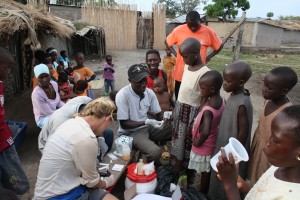Effects of co-infection on human health, the need for further research and steps towards integrated control
Introduction

Claire Standley and Moses Adriko surveying for malaria infections in a community in Uganda. Photo: Courtesy Dr Claire Standley
In large parts of the world, the Plasmodium protozoans that cause malaria co-exist alongside a number of other pathogens and parasites, many of which are also infectious to humans. One of the foremost challenges in tackling the huge burden of malaria around the world, and particularly in developing countries, is understanding the dynamics between malaria and these other infections. For example, researchers are seeking to understand the effects of co-infections on a patient’s health and well-being, while at the same time, deciphering how best to provide treatment and disease control regimes in regions with high co-infection prevalence. Moreover, of course, the effects and intricacies of co-infection may vary between regions, or between the types of infectious found alongside malaria. This blog gives a quick introduction to some of the common diseases often found alongside malaria, and especially in the developing world, where significant research resources are directed but also where treatment and control needs are greatest.
Malaria and HIV